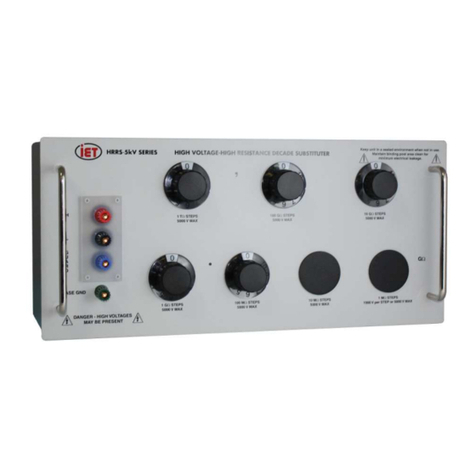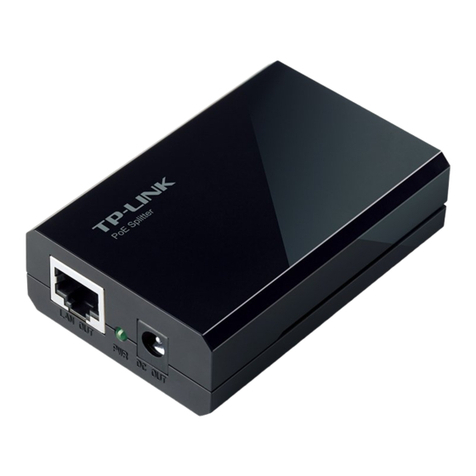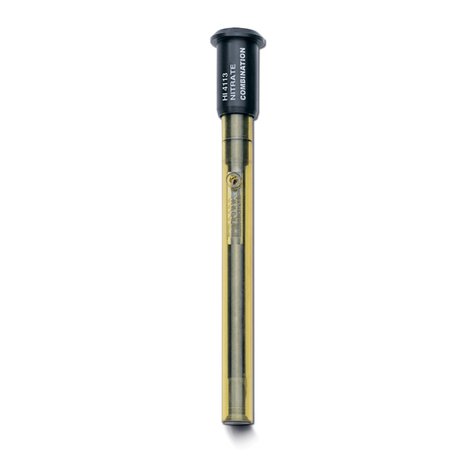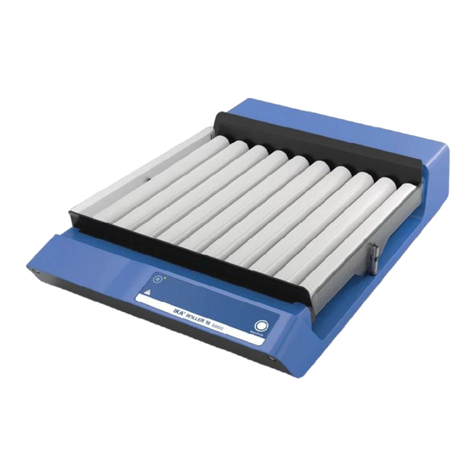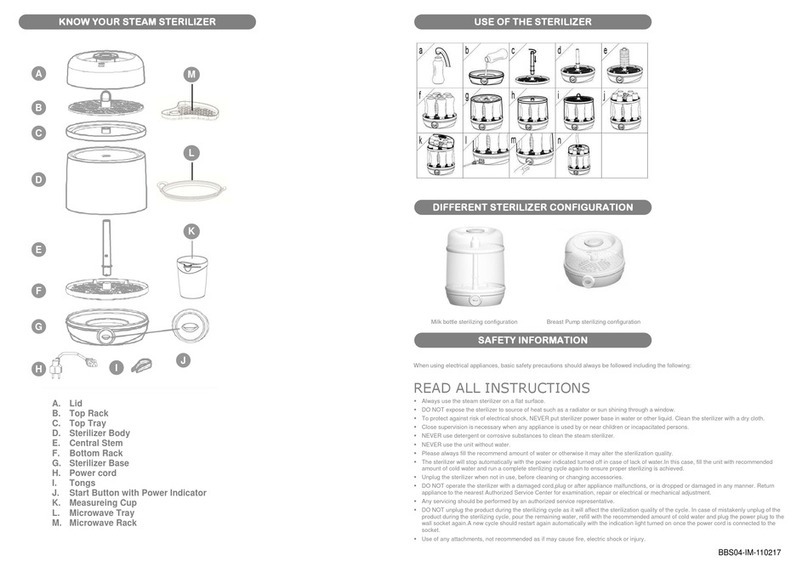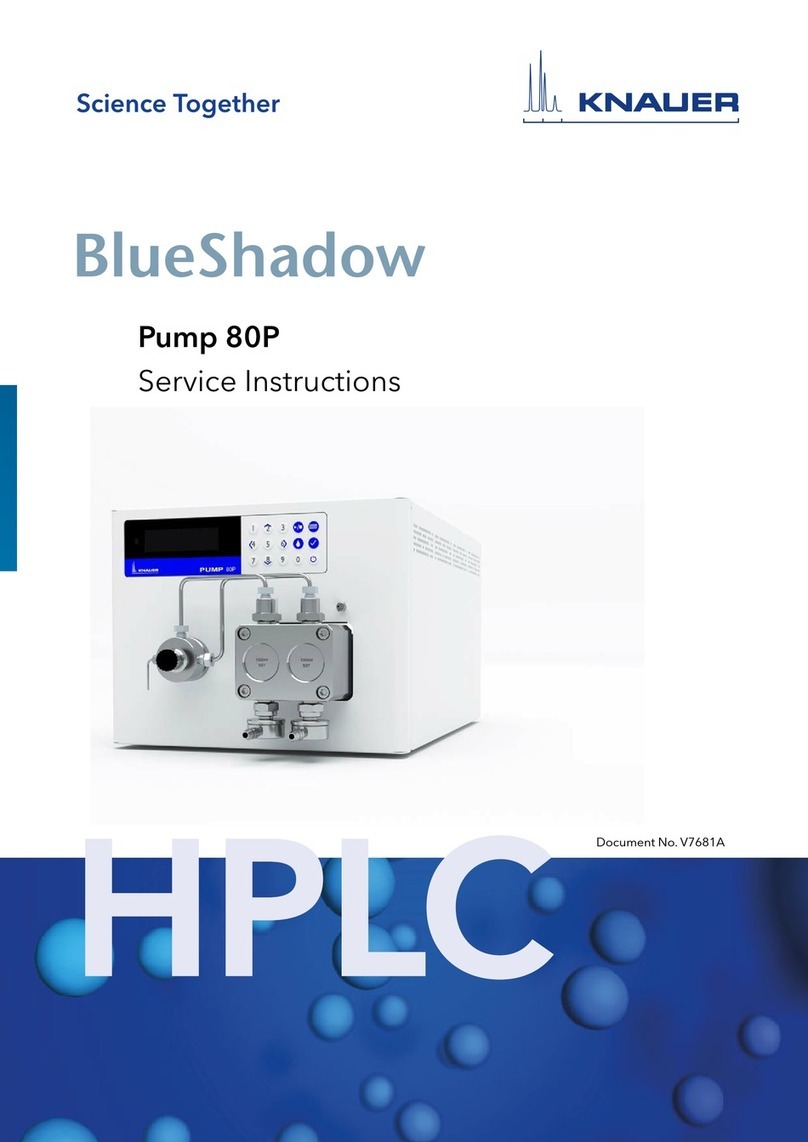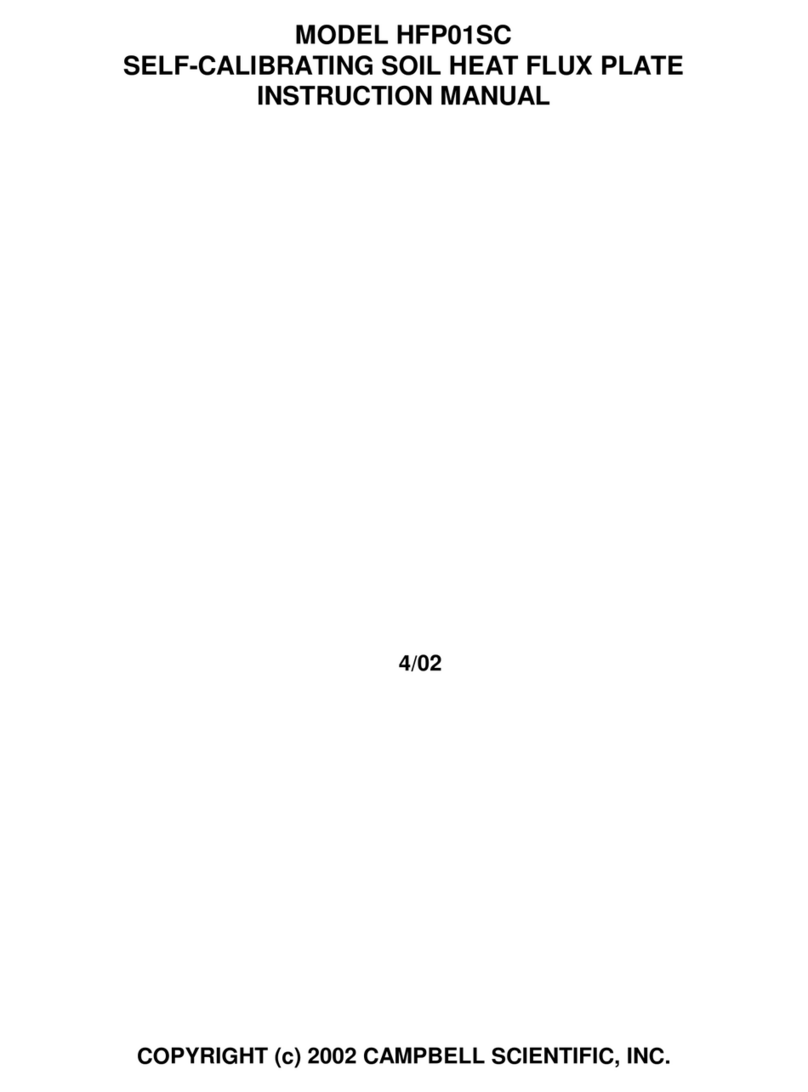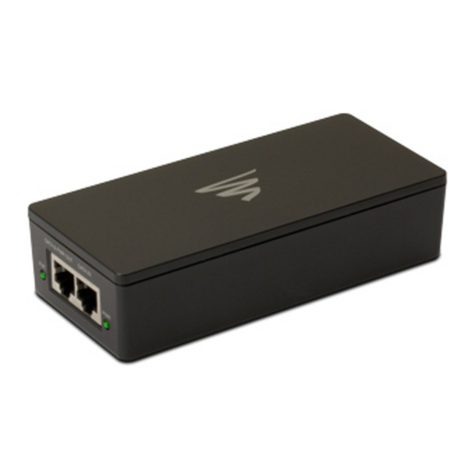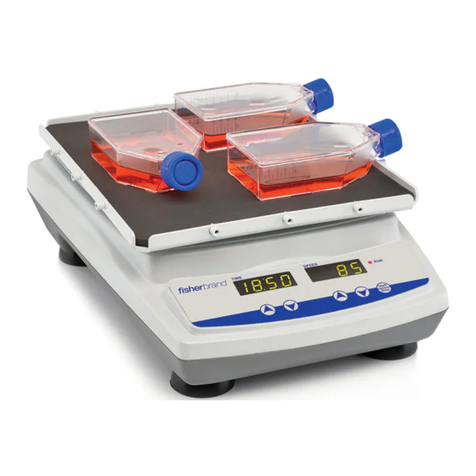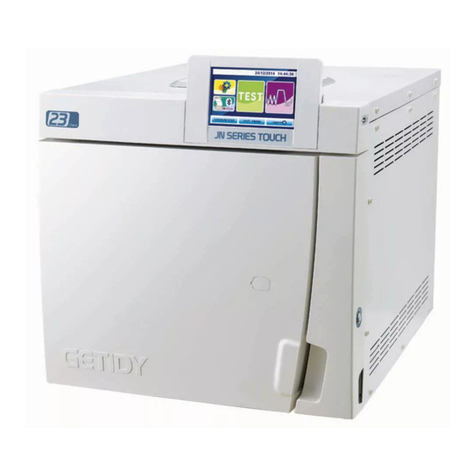iET SRL Series User manual

¨PRECISION INSTRUMENTS FOR TEST AND MEASUREMENT ¨
Email: inf[email protected]
TEL: (516) 334-5959 • FAX: (516) 334-5988
www.ietlabs.com
IET LABS, INC.
SRL Series
Resistance Standard
Operation Manual
Copyright © 2022 IET Labs, Inc.
Visit www.ietlabs.com for manual revision updates
SRL im/Oct 2022

¨PRECISION INSTRUMENTS FOR TEST AND MEASUREMENT ¨
Email: inf[email protected]
TEL: (516) 334-5959 • FAX: (516) 334-5988
www.ietlabs.com
IET LABS, INC.

WARRANTY
We warrant that this product is free from defects in material and workmanship and, when properly used,
will perform in accordance with applicable IET speci•cations. If within one year after original shipment,
it is found not to meet this standard, it will be repaired or, at the option of IET, replaced at no charge when
returned to IET. Changes in this product not approved by IET or application of voltages or currents greater
than those allowed by the speci•cations shall void this warranty. IET shall not be liable for any indirect,
special, or consequential damages, even if notice has been given to the possibility of such damages.
THIS WARRANTY IS IN LIEU OF ALL OTHER WARRANTIES, EXPRESSED OR IMPLIED,
INCLUDING BUT NOT LIMITED TO, ANY IMPLIED WARRANTY OF MERCHANTABILITY OR
FITNESS FOR ANY PARTICULAR PURPOSE.
i

ii
SRL Series
Safety Symbols
General de•nitions of safety symbols used on the instrument or in manuals are listed below.
Caution symbol: the product is marked with this symbol when it is necessary for the user to
refer to the instruction manual.
Hazardous voltage symbol: the product is marked with this symbol when high voltage maybe
present on the product and an electrical shock hazard can exist.
Indicates the grounding protect terminal, which is used to prevent electric shock from the
leakage on chassis. The ground terminal must connect to earth before using the product
Direct current.
Alternating current.
Frame or chassis terminal. A connection to the frame (chassis) of the equipment which
normally includes all exposed metal structures.
On supply.
O• supply.
Hot surface. Avoid contact. Surfaces are hot and may cause personal injury if touched.
Disposal
Waste Electrical and Electronic Equipment (WEEE) Directive 2002/96/EC
This product complies with the WEEE Directive (2002/96/EC) marking requirements.
The a!xed label indicates that you must not discard this electrical/ electronic product in domestic
household waste.
Product Category: With reference to the equipment types in the WEEE directive Annex 1, this product
is classi•ed as a “Monitoring and Control instrumentation” product.
Do not dispose of electrical appliances as unsorted municipal waste, use separate collection facilities.
Contact your local government for information regarding the collection systems available. If electrical
appliances are disposed of in land•lls or dumps, hazardous substances can leak into the groundwater
and get into the food chain, damaging your health and well-being.
When replacing old appliances with new one, the retailer is legally obligated to take back your old ap-
pliances for disposal.
Proposition 65 Warning for California Residents
WARNING: Cancer and Reproductive Harm - www.P65Warnings.ca.gov.
This product may contain chemicals known to the State of California to cause cancer, birth defects, or
other reproductive harm

iii
SRL Series
SAFETY PRECAUTIONS
The following general safety precautions must be observed during all phases of operation, service,
and repair of this instrument. Failure to comply with these precautions or with speci•c WARNINGS
elsewhere in this manual may impair the protection provided by the equipment. Such noncompliance
would also violate safety standards of design, manufacture, and intended use of the instrument.
IET Labs assumes no liability for the customer’s failure to comply with these precautions.
The SRL is an indoor use product.
DANGEROUS PROCEDURE WARNINGS
Comply with all WARNINGS - Procedures throughout in this manual and instructions on the
instrument prevent you from potential hazard. These instructions contained in the warnings must
be followed.
BEFORE APPLYING POWER
Verify that all safety precautions are taken. Make all connections to the instrument before applying
power. Note the instrument’s external markings described under “Safety Symbols”.
• DO NOT Operate in an Explosive Atmosphere
• Do not operate the instrument in the presence of in•ammable gasses or fumes
• Operation of any electrical instrument in such an environment clearly constitutes a safety
hazard
• Use Caution around live circuits and whenever hazardous voltages > 45 V are present
• Operators must not remove instrument covers
• Component replacement and internal adjustments must be made by quali•ed maintenance
personnel only
• DO NOT substitute parts or modify the instrument
• When working with high voltages; post warning signs, train personnel and keep unauthorized
personnel away.
To avoid the danger of introducing additional hazards, do not install substitute parts or perform
unauthorized modi•cations to the instrument.
Return the instrument to an IET Labs for service and repair to ensure that safety features are maintained
in operational condition.

WARNING
OBSERVE ALL SAFETY RULES
WHEN WORKING WITH HIGH VOLTAGES OR LINE VOLTAGES.
Dangerous voltages may be present inside this instrument. Do not open the case
Refer servicing to quali•ed personnel
HIGH VOLTAGES MAY BE PRESENT AT THE TERMINALS OF THIS INSTRUMENT
WHENEVER HAZARDOUS VOLTAGES (> 45 V) ARE USED, TAKE ALL MEASURES TO
AVOID ACCIDENTAL CONTACT WITH ANY LIVE COMPONENTS.
USE MAXIMUM INSULATION AND MINIMIZE THE USE OF BARE
CONDUCTORS WHEN USING THIS INSTRUMENT.
Use extreme caution when working with bare conductors or bus bars.
WHEN WORKING WITH HIGH VOLTAGES, POST WARNING SIGNS AND
KEEP UNREQUIRED PERSONNEL SAFELY AWAY.
CAUTION
DO NOT APPLY ANY VOLTAGES OR CURRENTS TO THE TERMINALS OF THIS
INSTRUMENT IN EXCESS OF THE MAXIMUM LIMITS INDICATED ON
THE FRONT PANEL OR THE OPERATING GUIDE LABEL.
iv

Contents
Chapter 1 Introduction ..............................................................................1
1.1 Introduction........................................................................................................... 1
Chapter 2 Specifications ...........................................................................2
Speci!cations ................................................................................................................ 2
Chapter 3 Operation ..................................................................................4
3.1 Initial Inspection and Setup .................................................................................. 4
3.2 Connections........................................................................................................... 4
3.2.1 Connections for values "190 k# ................................................................ 4
3.2.2 Connections for values $ 1 M# and >100 M# .......................................... 4
3.2.3 Connections for values $100 M#............................................................... 5
3.3 Thermal emf Considerations................................................................................. 5
3.4 Temperature Coe%cient Constants ....................................................................... 6
3.5 Environmental Conditions .................................................................................... 6
3.5.1 Operating Temperature ............................................................................... 6
3.5.2 Storage Temperature ................................................................................... 6
3.6 Shipping and Handling ......................................................................................... 6
Chapter 4 Maintenance..............................................................................7
4.1 Maintainability and Reliability ............................................................................. 7
4.2 Preventive Maintenance........................................................................................ 7
4.3 Calibration............................................................................................................. 7
4.3.1 Calibration Interval..................................................................................... 7
4.3.2 General Considerations............................................................................... 7
4.3.3 Required Equipment ................................................................................... 8
4.3.4 Calibration Procedure ................................................................................. 8
4.4 Replaceable Parts List........................................................................................... 8
v

Figures and Tables
Figure 1-1: SRL Series Resistance Standard .............................................1
Figure 2-1: OPERATION GUIDE affixed to unit...........................................2
Figure 2-2: Temperature Calibration Chart..................................................2
Table 2-1: SRL Specifications .....................................................................3
Figure 3-1: Connections for values £190 kW...............................................4
Table 3-1: Connections for values £190 kW................................................4
Figure 3-2: Connections for values ³1 MWand >100 MW..........................4
Table 3-2: Connections for values ³1 MWand >100 MW............................4
Figure 3-3: Connections for values ³100 MW..............................................5
Table 3-3: Connections for values ³100 MW................................................5
Figure 3-4: Resistance vs. temperature relationship ...................................6
Figure 3-5: Temperature Calibration Chart..................................................6
Table 4-1: Replaceable Parts List................................................................8
Figure 4-1: SRL Replaceable Parts.............................................................8
vi

1
SRL Series
1Introduction
Chapter 1
INTRODUCTION
1.1 Introduction
The SRL Series (Figure 1.1) are extremely stable,
precise, laboratory or portable resistance standards.
Their ruggedness and small size plus their virtually
zero temperature coe•cient makes the SRL Series
ideal for any applications outside of laboratory en-
vironment within the temperature range of 18°C to
28°C. The temperature chart provided with each unit
enhances the accuracy by indicating the deviation
from nominal for the operating temperature range in
0.5°C increments. Because of the low temperature
coe•cient, they require no oil-or-temperature bath.
The SRL series units are available in values ranging
from 1 m• to 2 T•, with custom values available,
to satisfy any need. They are built with precision
resistors and use no adjustable resistors of any kind.
To further reduce errors caused by temperature
changes, the SRL units are built with a temperature
coe•cient of near zero at 23°C. The binding posts
are constructed of low-thermal emf material.
Figure 1-1: SRL Series Resistance Standard

2
SRL Series
2 Specifications
Chapter 2
SPECIFICATIONS
For convenience to the user, the pertinent speci•cations are given in an OPERATION GUIDE, shown in Figures
2-1 and 2-2, a!xed to the case of the instrument.
SPECIFICATIONS
Accuracy and other speci!cations:
See Table 2-1.
Retrace:
1 " to 19 M#: Permanent shift in resistance value
is <2 ppm for 23°C to 0°C to 23°C cycle, and 23°C
to 40°C to 23°C cycle
Calibration Report:
Initial SI traceable calibration data provided in
0.5°C increments for temperature range of 18°C to
28°C as shown in Figure 2-2.
Calibration Conditions:
Three of four-wire Kelvin measurements, low
power, at 23°C; two wire for 1 M" and over.
Traceable to SI
Terminals:
Gold-plated, tellurium-copper, low-thermal-emf binding
posts on standard 3/4 inch spacing. A GROUND terminal
is provided on all units.
#190 k$: four 5-way binding posts for 4-terminal
measurement
<190 k$: two 5-way binding posts
%100 M$: two 5-way binding posts with GUARD
Other available terminals:
• DMM direct input compatibles
• bnc, Triax, and custom connectors
Transit Case:
Optional Model SRC-100 lightweight transit case
with handle, suitable for transporting and storing
two units. The case provides mechanical protection
and insulation from temperature changes during
transportation or shipping.
Dimensions:
8.6 cm H x 10.5 cm W x 12.7 cm D (3.4” x 4.15” x 5”)
Weight:
0.73 kg (1.6 lb)
Figure 2-1: OPERATION GUIDE affixed to unit
Figure 2-2: Temperature Calibration Chart
JOS
19-Jun-2002
SRL-1 B2-9240246
N/A
1.000 003 3
N/A
N/A
SRL-1 STANDARD RESISTOR
±2 ppm
±3 ppm
18°C to 28°C
0.5 V
500 mA
8 ppm per year max; 2
ppm typical.
<2 ppm for for max.
temp. cycles.
-1.6E-07 -2.4E-08
19-Jun-2001
23.0°C
Adjustment to Nominal:
Max. Change from 23°C
value (18°C to 28°C):
Operating Temperature
Range:
Max. Voltage:
Max. Current:
Stability:
Retrace:
Date Calibrated
Temperature (°C)
Relative Humidity
Resistance R
Test Conditions
Meas. Uncertainty
By
Recommended Due
www.ietlabs.com
IET LABS, INC.
534 Main Street, Westbury, NY 11590
800-899-8438 • 516-334-5959
(FAX) 516-334-5988
Model: SN:
R
t
= R
23
[1 + α ( t - 23 ) + β( t - 23 )
2
]; α=β=
23
JOS
19-Jun-2001
1.000 003 3
SRL-1
B2-9240246 0
-1.6E-07 -2.4E-08
3.0
2.9
2.1
1.9
2.7
2.6
2.4
2.3
3.4
3.3
3.2
3.1
3.5
3.5
3.6
3.6
3.6
3.6
3.5
1.000 002 1
1.000 003 5
1.000 003 5
1.000 003 4
1.000 003 4
3.5
3.4
1.000 001 9
1.000 003 3
1.000 003 2
1.000 003 1
1.000 003 0
1.000 002 9
1.000 002 7
1.000 002 6
1.000 002 4
1.000 002 3
1.000 003 5
1.000 003 5
1.000 003 6
1.000 003 6
1.000 003 6
1.000 003 6
28.0
26.0
26.5
27.0
27.5
24.0
24.5
25.0
25.5
22.0
22.5
23.0
23.5
20.0
20.5
21.0
21.5
18.0
18.5
19.0
19.5
Temperature Calibration Chart
Model:
SN:
Alpha:
Report No:
Beta:
Temperature
(°C)
Deviation from
Nominal
(ppm)
Measured value at 23°C:
Date:
By:
IET LABS, INC.
• (516) 334-5959
• (800) 899-8438
• 534 Main Street, Westbury, NY 11590
Traceable to NIST
Resistance

3
SRL Series
3Specifications
Nominal
Value
Model
Number
Adjustment to
Nominal
Stability per
year (max
change)
Max Resistance
Change 18-28°C
from 23 °C
Max Applied Power Typical change
at 1 kHz Terminals
0 ppm change* 1 ppm change** 3 ppm change**
1 mΩ SRL-0.001 ±100 ppm ±50 ppm 25 ppm/°C
<100 ppm
4 bp's + gnd
10 mΩ SRL-0.01 ±5 ppm ±15 ppm 5 ppm/°C 25 mW 50 mW 200 mW 4 bp's + gnd
19 mΩ SRL-0.019 ±5 ppm ±15 ppm 5 ppm/°C 25 mW 50 mW 200 mW 4 bp's + gnd
20 mΩ SRL-0.02 ±5 ppm ±15 ppm 5 ppm/°C 25 mW 50 mW 200 mW 4 bp's + gnd
100 mΩ SRL-0.1 ±5 ppm ±12 ppm 2 ppm/°C 50 mW 100 mW 250 mW 4 bp's + gnd
190 mΩ SRL-0.19 ±5 ppm ±12 ppm 2 ppm/°C 50 mW 100 mW 250 mW 4 bp's + gnd
200 mΩ SRL-0.2 ±5 ppm ±12 ppm 2 ppm/°C 50 mW 100 mW 250 mW 4 bp's + gnd
1 Ω SRL-1 ±2 ppm ±8 ppm 3 ppm tot 175 mW 350 mW 850 mW 4 bp's + gnd
1.9 Ω SRL-1.9 ±2 ppm ±8 ppm 3 ppm tot 175 mW 350 mW 850 mW 4 bp's + gnd
2 Ω SRL-2 ±2 ppm ±8 ppm 3 ppm tot 175 mW 350 mW 850 mW 4 bp's + gnd
10 Ω SRL-10 ±2 ppm ±8 ppm 3 ppm tot 100 mW 200 mW 500 mW 4 bp's + gnd
19 Ω SRL-19 ±2 ppm ±8 ppm 3 ppm tot 100 mW 200 mW 500 mW 4 bp's + gnd
20 Ω SRL-20 ±2 ppm ±8 ppm 3 ppm tot 100 mW 200 mW 500 mW 4 bp's + gnd
25 Ω SRL-25 ±2 ppm ±8 ppm 3 ppm tot 100 mW 200 mW 500 mW 4 bp's + gnd
30 Ω SRL-30 ±2 ppm ±8 ppm 3 ppm tot 100 mW 200 mW 500 mW 4 bp's + gnd
50 Ω SRL-50 ±2 ppm ±8 ppm 3 ppm tot 100 mW 200 mW 500 mW 4 bp's + gnd
100 Ω SRL-100 ±2 ppm ±6 ppm 3 ppm tot 100 mW 200 mW 500 mW 4 bp's + gnd
190 Ω SRL-190 ±2 ppm ±6 ppm 3 ppm tot 100 mW 200 mW 500 mW 4 bp's + gnd
200 Ω SRL-200 ±2 ppm ±6 ppm 3 ppm tot 100 mW 200 mW 500 mW 4 bp's + gnd
350 Ω SRL-350 ±2 ppm ±6 ppm 3 ppm tot 100 mW 200 mW 500 mW 4 bp's + gnd
400 Ω SRL-400 ±2 ppm ±6 ppm 3 ppm tot 100 mW 200 mW 500 mW 4 bp's + gnd
1 kΩ SRL-1K ±2 ppm ±6 ppm 3 ppm tot 100 mW 200 mW 500 mW 4 bp's + gnd
1 kΩ SRL-1K-TC ±2 ppm ±6 ppm 2 ppm tot 100 mW 200 mW 500 mW 4 bp's + gnd
1.9 kΩ SRL-1.9K ±2 ppm ±6 ppm 2 ppm tot 100 mW 200 mW 500 mW 4 bp's + gnd
2 kΩ SRL-2K ±2 ppm ±6 ppm 2 ppm tot 100 mW 200 mW 500 mW 4 bp's + gnd
4 kΩ SRL-4K ±2 ppm ±4 ppm 2 ppm tot 100 mW 200 mW 500 mW 4 bp's + gnd
10 kΩ SRL-10K ±2 ppm ±4 ppm 1.5 ppm tot 100 mW 200 mW 500 mW 4 bp's + gnd
19 kΩ SRL-19K ±2 ppm ±4 ppm 2 ppm tot 100 mW 200 mW 500 mW 4 bp's + gnd
20 kΩ SRL-20K ±2 ppm ±4 ppm 2 ppm tot 100 mW 200 mW 500 mW 4 bp's + gnd
100 kΩ SRL-100K ±2 ppm ±6 ppm 2 ppm tot 100 mW 200 mW 500 mW
<200 ppm
4 bp's + gnd
190 kΩ SRL-190K ±2 ppm ±8 ppm 2 ppm tot 100 mW 200 mW 500 mW 4 bp's + gnd
200 kΩ SRL-200K ±2 ppm ±8 ppm 2 ppm tot 100 mW 200 mW 500 mW 4 bp's + gnd
1 MΩ SRL-1M ±2 ppm ±8 ppm 2 ppm tot 100 mW 200 mW 500 mW
<1000 ppm
2 bp's + gnd
1.9 MΩ SRL-1.9M ±2 ppm ±9 ppm 3 ppm tot 100 mW 200 mW 500 mW 2 bp's + gnd
2 MΩ SRL-2M ±2 ppm ±9 ppm 3 ppm tot 100 mW 200 mW 500 mW 2 bp's + gnd
10 MΩ SRL-10M ±2 ppm ±9 ppm 3 ppm tot 500 V 1000 V 2500 V <2 % 2 bp's + gnd
19 MΩ SRL-19M ±2 ppm ±10 ppm 4 ppm tot 1000 V 2000 V 5000 V
NA
2 bp's + gnd
20 MΩ SRL-20M ±2 ppm ±10 ppm 4 ppm tot 1000 V 2000 V 5000 V 2 bp's + gnd
100 MΩ SRL-100M ±10 ppm ±20 ppm 5 ppm/°C 2000 V 4000 V 5000 V 2 bp's + gnd + guard
190 MΩ SRL-190M ±10 ppm ±20 ppm 5 ppm/°C 2000 V 5000 V 2 bp's + gnd + guard
200 MΩ SRL-200M ±10 ppm ±20 ppm 5 ppm/°C 5000 V 2 bp's + gnd + guard
1 GΩ SRL-1G ±0.1% ±200 ppm 23 ppm/°C 5000 V 2 bp's + gnd + guard
1.9 GΩ SRL-1.9G ±0.1% ±200 ppm 23 ppm/°C 5000 V 2 bp's + gnd + guard
2 GΩ SRL-2G ±0.1% ±200 ppm 23 ppm/°C 5000 V 2 bp's + gnd + guard
10 GΩ SRL-10G ±0.1% ±500 ppm 25 ppm/°C 5000 V 2 bp's + gnd + guard
19 GΩ SRL-19G ±0.1% ±500 ppm 25 ppm/°C 5000 V 2 bp's + gnd + guard
20 GΩ SRL-20G ±0.1% ±500 ppm 25 ppm/°C 5000 V 2 bp's + gnd + guard
100 GΩ SRL-100G ±0.3% ±500 ppm 25 ppm/°C 5000 V 2 bp's + gnd + guard
190 GΩ SRL-190G ±0.3% ±500 ppm 25 ppm/°C 5000 V 2 bp's + gnd + guard
200 GΩ SRL-200G ±0.3% ±500 ppm 25 ppm/°C 5000 V 2 bp's + gnd + guard
1 TΩ SRL-1T ±0.5% ±500 ppm 50 ppm/°C 5000 V 2 bp's + gnd + guard
1.9 TΩ SRL-1.9T ±0.7% ±1000 ppm 100 ppm/°C 5000 V 2 bp's + gnd + guard
2 TΩ SRL-2T ±0.7% ±1000 ppm 100 ppm/°C 5000 V 2 bp's + gnd + guard
XXX Ω SRL-XXX customer-selected value and power specifications
* negligible effect of self-heating; do not exceed voltage limits where given.
** non-permanent self-heating change; exceeding power given for 3 ppm change may cause a permanent change in the resistance.
Table 2-1: SRL Specifications

4
SRL Series
4 Operation
Chapter 3
OPERATION
3.1 Initial Inspection and Setup
This instrument was carefully inspected before ship-
ment. It should be in proper electrical and mechanical
order upon receipt.
An OPERATION GUIDE is attached to the case
of the instrument to provide ready reference to
speci!cations.
3.2 Connections
The SRL series has three di"erent types of connec-
tions listed below.
3.2.1 Connections for values
£190 kW
Values #190 k$ have four insulated low thermal
emf binding posts for four-terminal measurements as
shown in Figure 3-1. The !fth binding post is con-
nected to the case. For high-resistance models (e.g.
>10 k%) two-terminal measurements may be made
by shorting HI to HI and LO to LO, preferably with
shorting links or other substantial means.
Figure 3-1: Connections for values £190 kW
1 W
RESISTANCE STANDARD
MODEL SRL-1
Maximum Resistance Change (18°C to 28°C): ±3 ppm
Maximum Voltage: 0.5 V
Maximum Current: 0.5 A
LO
HI
LO
HI
SENSE
CURRENT
GND
HI INPUT
HI SENSE
LO INPUT
LO SENSE
GROUND
Binding Post Function
CURRENT HI Current input from source (e.g. ohmmeter)
CURRENT LO Current return to source (e.g. ohmmeter)
SENSE HI Measurement point for a four-wire ohmmeter
SENSE LO Measurement point for a four-wire ohmmeter
GND Guard or shield
Table 3-1: Connections for values £190 kW
3.2.2 Connections for values
> 190 kWand <100 MW
Values > 190 k$ and <100 M$ have two insulated,
low thermal emf binding posts for two-terminal mea-
surements as shown in Figure 3-2. The third binding
post is connected to the case.
Figure 3-2: Connections for values > 190 kW
and <100 MW
Binding Post Function
HI Input from source (e.g. ohmmeter)
SENSE LO Measurement point
GND Guard or shield
Table 3-2: Connections for values > 190 kW
and <100 MW
HI INPUT
HI SENSE
1 MW
LO
HI
GND
RESISTANCE STANDARD
MODEL SRL-1M
Maximum Resistance Change (18°C to 28°C): ±2 ppm
Maximum Voltage: 100 V
Maximum Current: 0.1 mA
LO SENSE
LO INPUT
GROUND

5
SRL Series
5Operation
3.2.3 Connections for values
³100 MW
Values ≥100 MΩ have two insulated, low thermal
emf binding posts for two-terminal measurements as
shown in Figure 3-3. The third binding post, labeled
GROUND, is connected to the case. The fourth
binding post, labeled GUARD, is connected to an
internal case that contains the resistor.
Figure 3-3: Connections for values ³100 MW
Binding Post Function
HI Input from source (e.g. ohmmeter)
SENSE LO Measurement point
GROUND Shield
GUARD Interrupts leakage from the internal resistor to
the case and other components of the unit
Table 3-3: Connections for values ³100 MW
RESISTANCE STANDARD
MODEL SRL-100M
Temperature Coefficient: 5 ppm/°C
Maximum Voltage: 1000 V
100 MW
LO
HI
GROUND
GUARD
HI INPUT
HI SENSE
LO SENSE
LO INPUT
GROUND
GUARD*
*If no GUARD point exists on the measuring instrument,
it may be connected to GROUND.
3.3 Thermal emf Considerations
High-quality, gold-plated, tellurium-copper binding
posts serve to minimize the thermal emf effects which
would artificially reflect a change in dc resistance
measurements. All other conductors within the
instrument, as well as the solder used, contain no
metals or junctions that could contribute to thermal
emf problems.
There nevertheless may be some minute thermal emf
generated at the test leads where they contact the gold
banana jacks. This voltage will also be eliminated if
a meter with so called “True Ohm” capability is used.
Otherwise the generated emf may represent itself as a
false component of the dc resistance measurement.
Always use low emf test leads when working with
SRL models. In particular, avoid brass or steel
conductors.

6
SRL Series
6 Operation
3.4 Temperature Coefficient Constants
The change of resistance with temperature for each
standard is accurately expressed by the equation:
Rt=R23[1+a(t-23)+ß(t-23)2]
Rt=Resistance at (°C)
R23 = Resistance at 23°C
a = Slope of the curve (ppm/°C) at 23°C
ß = Rate of change of slope of the curve (ppm/°C2)
The values of
aand ß are given with each unit.
Experience shows that these values do not change
appreciably with time and hence need to be deter-
mined only once.
The resistance vs. temperature relationship is shown
in Figure 3-4. The value at any temperature may be
obtained from the above formula, or the temperature
calibration chart shown in Figure 3-5.
Figure 3-4: Resistance vs. temperature
relationship
Approximate Temperature (°C)
-3
-2.5
-2
-1.5
-1
-0.5
0
0.5
1
-0.5% -0.4% -0.3% -0.2% -0.1% 0.0% 0.1% 0.2% 0.3% 0.4% 0.5%
Figure 3-5: Temperature Calibration Chart
3.5 Environmental Conditions
3.5.1 Operating Temperature
For optimal accuracy, SRL Models should be used
in an environment of 23°C ±5°C. They should be
allowed to stabilize at those temperatures after any
signi!cant temperature variation. For determina-
tion of accuracy for other temperatures consult the
Temperature Calibration Chart provided with each
unit. The calculated resistance value is provided be-
tween 18°C and 28°C in 0.5°C increments. Figure
2-2 shows an example of this table.
3.5.2 Storage Temperature
The SRL Series should be maintained within the
storage temperature range of 0°C to 40°C to retain
its accuracy within the speci!ed limits.
3.6 Shipping and Handling
The SRL Series should not be exposed to any excessive
shock or temperature extremes. The option SRC-100, a
lightweight transit case capable of storing two SRL units,
is recommended for shipping or transporting the models.
JOS
19-Jun-2001
1.000 003 3
SRL-1
B2-9240246 0
-1.6E-07 -2.4E-08
3.0
2.9
2.1
1.9
2.7
2.6
2.4
2.3
3.4
3.3
3.2
3.1
3.5
3.5
3.6
3.6
3.6
3.6
3.5
1.000 002 1
1.000 003 5
1.000 003 5
1.000 003 4
1.000 003 4
3.5
3.4
1.000 001 9
1.000 003 3
1.000 003 2
1.000 003 1
1.000 003 0
1.000 002 9
1.000 002 7
1.000 002 6
1.000 002 4
1.000 002 3
1.000 003 5
1.000 003 5
1.000 003 6
1.000 003 6
1.000 003 6
1.000 003 6
28.0
26.0
26.5
27.0
27.5
24.0
24.5
25.0
25.5
22.0
22.5
23.0
23.5
20.0
20.5
21.0
21.5
18.0
18.5
19.0
19.5
Temperature Calibration Chart
Model:
SN:
Alpha:
Report No:
Beta:
Temperature
(°C)
Deviation from
Nominal
(ppm)
Measured value at 23°C:
Date:
By:
IET LABS, INC.
• (516) 334-5959
• (800) 899-8438
• 534 Main Street, Westbury, NY 11590
Traceable to NIST
Resistance

7
SRL Series
7Maintenance
Chapter 4
MAINTENANCE
4.1 Maintainability and Reliability
It is possible to maintain SRL units inde•nitely. They
are reliable due to their closed, rugged design and
sealed resistors. The units are resistant to electro-
magnetic interference (EMI) because of their metal
enclosure.
4.2 Preventive Maintenance
Keep the SRL units in a clean environment. This will
help prevent possible contamination.
The front panel may be cleaned to eliminate any leak-
age paths from near or around the binding posts. To
clean the front panel:
Wipe the front panel clean using alcohol and a
lint-free cloth.
4.3 Calibration
The SRL units may be employed as stand-alone in-
struments or as an integral components of a system.
If used as part of a system, they should be calibrated
as part of the overall system to provide an optimum
system calibration.
If an SRL model is employed as a stand-alone device,
the following should be observed:
• Calibration Interval
• General Considerations
• Required Equipment
• Calibration Procedure
4.3.1 Calibration Interval
The recommended SRL Series calibration interval is
twelve (12) months.
If the instrument is used to transfer resistance values
only, recalibration is not required, assuming that there
has been no drastic change of value.
4.3.2 General Considerations
Before starting the calibration procedure, you need
to consider the following:
• Calibration environment should be 23°C and
less than 50% relative humidity.
• Test instruments should be su!ciently more
accurate than the SRL unit, and/or the uncer-
tainty of the measurement instrumentation
has to be considered in the calibration Test
Uncertainty Ratio (TUR).
• The testing equipment and the SRL unit
should stabilize at laboratory conditions for
at least 24 hours.
• Kelvin type 4-wire test leads should be
used to obtain accurate low resistance
measurements.
• Steps should be taken to minimize thermal
emf e"ects, such as using a meter with “True
Ohm” capacity.
• Accepted metrology practices should be
followed.

8
SRL Series
8 Maintenance
4.3.3 Required Equipment
Many combinations of standards, transfer stan-
dards, meters, and bridges may be used to calibrate
this instrument. The following are some possible
choices:
• Resistance Standards or Transfer Standards
for the required values with traceable cali-
brations, such as the following standards
available from IET Labs
• SR-102 100 Ω
• SR-103 1 kΩ
• SR-104 10 kΩ
• SRL series
• Precision resistance measurement bridge
or multimeter, with a transfer accuracy
of ±l ppm. Options include:
• Measurements International Model
6010C, 6000B
• ESI model 242, 242A, 242C, or
242D
• A high-precision, high-stability digi-
tal multimeter (e.g. Fluke 8508A)
along with a set of resistance stan-
dards for ratio mode.
4.3.4 Calibration Procedure
To calibrate an SRL unit, proceed as follows:
1. Set up the calibration equipment in the resis-
tance measurement mode.
2. Confirm the resistance of the unit.
Allow a confidence band for the uncer-
tainty of the measuring instrument and
setup.
3. Confirm that the resistance is consistent with
historical measurements.
4.4 Replaceable Parts List
Reference IET Pt No Description
1BP-1000-RD Binding Post, Red
2BP-1000-BK Binding Post, Black
3BP-1000-GN Binding Post, Green
3BP-1000-BL Binding Post, Blue
Not Shown SRL-*-Res SRL resistor assembly
Replace * with nominal resistance value
Table 4-1: Replaceable Parts List
Figure 4-1: SRL Replaceable Parts
12
3
4

This manual suits for next models
49
Table of contents
Other iET Laboratory Equipment manuals
Popular Laboratory Equipment manuals by other brands
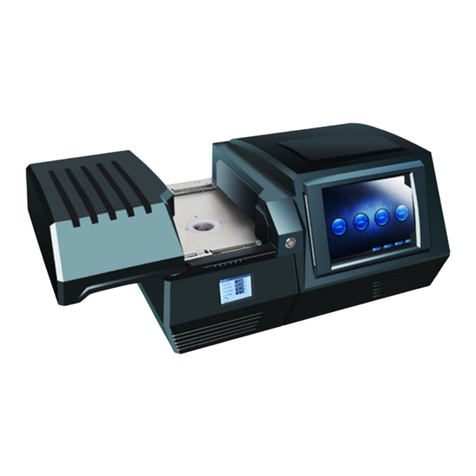
NAPCO
NAPCO NAP9600 user manual
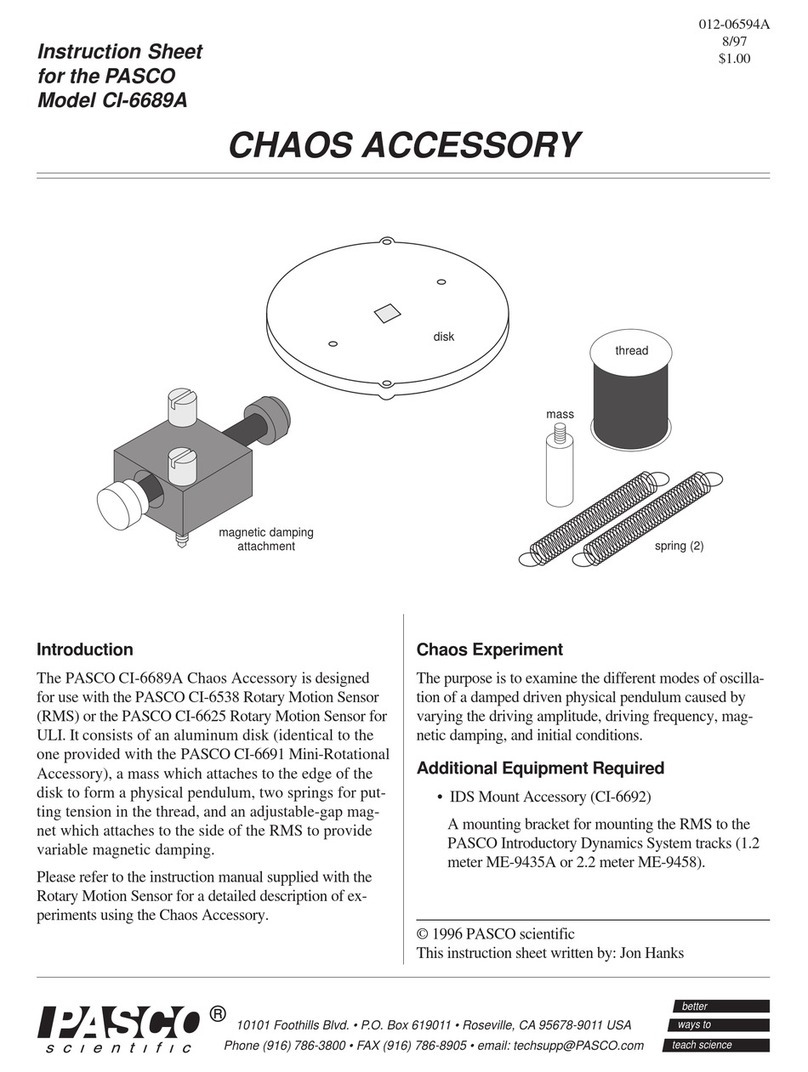
Pasco Scientific
Pasco Scientific CI-6689A instruction sheet

ThermoFisher Scientific
ThermoFisher Scientific HyPerforma S.U.F. user guide

Fisher Scientific
Fisher Scientific Fisherbrand accuSpin Micro Series instruction manual
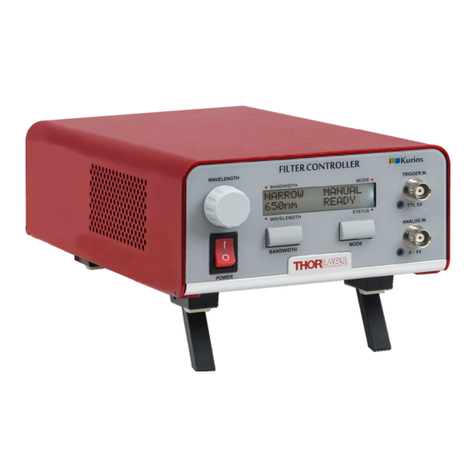
THORLABS
THORLABS KURIOS-WB1 user guide
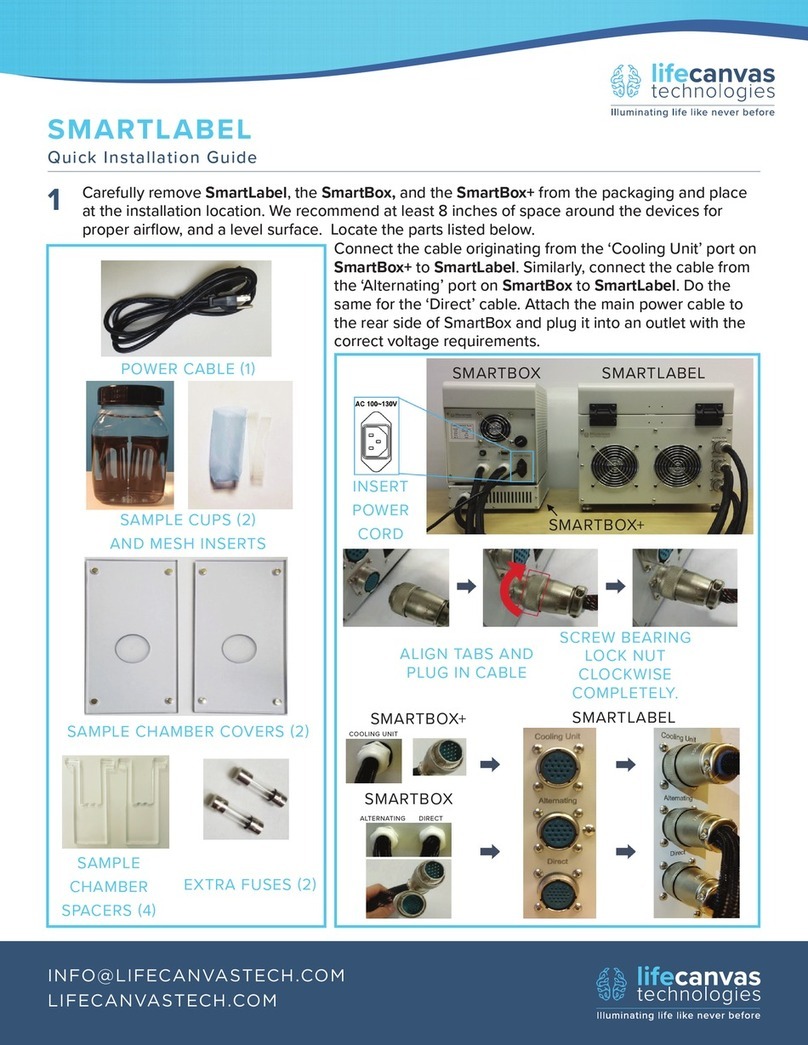
Lifecanvas Technologies
Lifecanvas Technologies SMARTLABEL Quick installation guide
